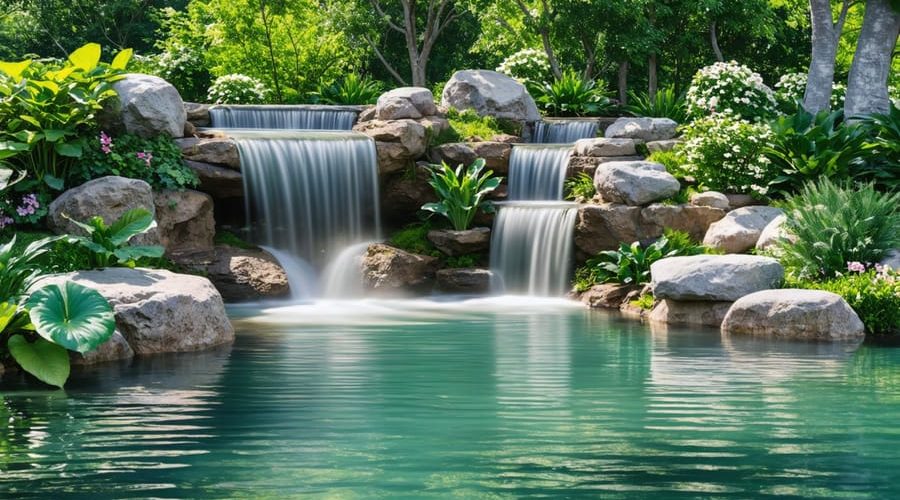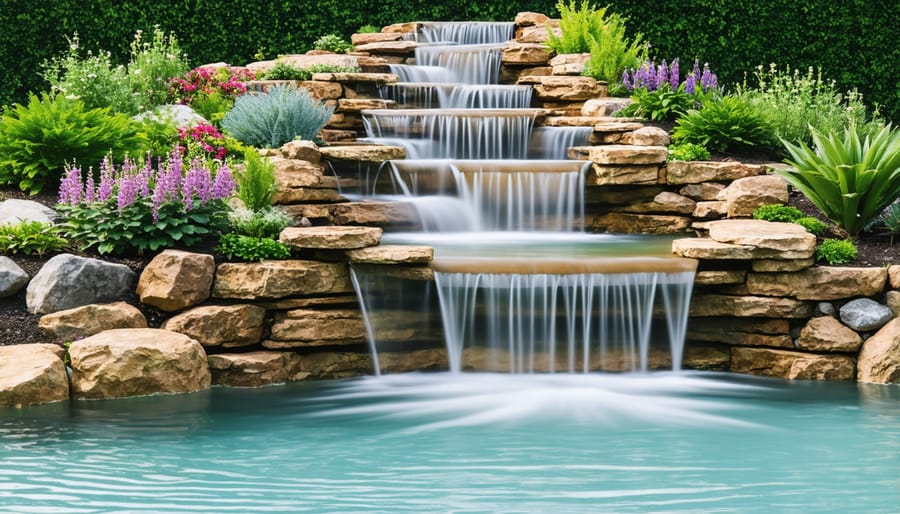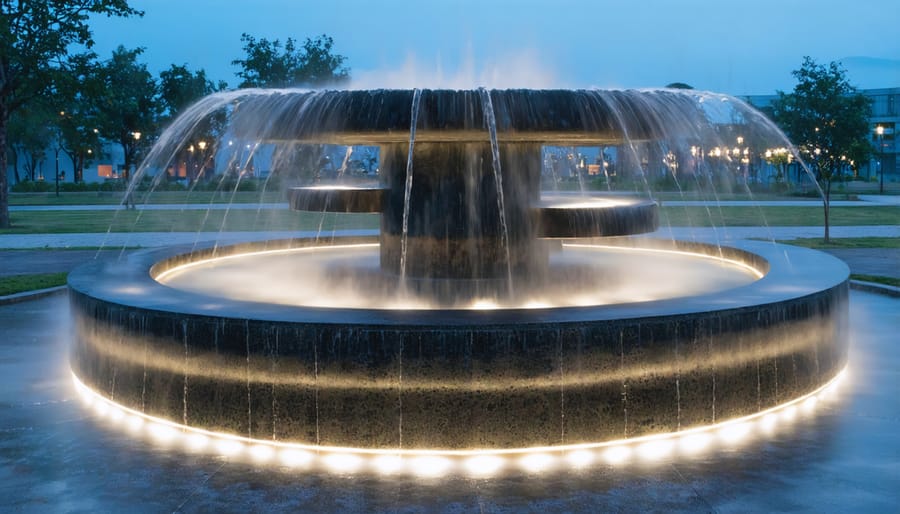
Transform Your Garden Pond into a Living Symphony of Sound and Art
Transform your backyard into a living masterpiece with an artistic garden pond that engages all the senses. Picture the gentle cascade of water over hand-selected stones, creating a melodic symphony that draws both wildlife and wonder. Unlike traditional water features, artistic design ponds blend sculptural elements, strategic plantings, and thoughtful soundscaping to create an immersive outdoor experience that evolves through every season.
Modern pond design has transcended the basic kidney-shaped pool, embracing organic curves, architectural elements, and innovative materials that mirror contemporary art installations. Whether you’re envisioning a minimalist Zen retreat with clean lines and carefully placed koi, or a naturalistic wonderland bursting with native aquatic plants and creative hardscaping, the possibilities for artistic expression are limitless.
The secret to creating these living art pieces lies in understanding how to balance aesthetic appeal with ecological function. By carefully considering elements like sight lines, water movement, and plant composition, you can craft a sustainable water feature that serves as both a stunning focal point and a thriving ecosystem. This guide will explore how to merge artistic vision with practical design principles to create a garden pond that’s truly extraordinary.
Natural Water Music: Understanding Pond Acoustics
The Science of Water Sounds
Water creates different sounds depending on how it moves, making it a powerful tool for creating the perfect garden atmosphere. When water trickles down rocks, it produces a gentle, tinkling sound that many find calming. Larger waterfalls create a more dramatic white noise effect that’s excellent for masking unwanted sounds from traffic or neighbors.
The height from which water falls plays a crucial role in sound production. A drop of just a few inches creates soft ripples, while drops of several feet produce deeper, more resonant tones. The surface the water lands on also matters – water hitting water makes a different sound than water striking stone or metal.
To create a soothing soundscape, consider combining different water movements. A mixture of cascading falls, gentle streams, and still pools provides layers of sound that change as you move through your garden. The width of water flows also affects the sound – narrow streams produce higher pitches, while broader falls create fuller, lower tones.
Remember that sound travels differently outdoors than indoors, so test your water features at different times of day and from various garden locations to achieve the perfect acoustic balance.
Choosing Your Water Symphony
Water can transform your garden pond from a simple feature into a mesmerizing symphony of sounds. Gentle ripples create a soothing backdrop that melts away stress, while cascading waterfalls add drama and energy to your outdoor space. For ultimate relaxation, consider a subtle bubbling effect from a small fountain, which mimics the peaceful sound of a natural spring.
Different water features create distinct moods: a tall waterfall produces white noise that helps mask urban sounds, while multiple smaller drops create a playful, musical quality. For meditation spaces, try a gentle water bowl with a slow overflow that produces a crystalline trickling sound. Strategically placed rocks can enhance these effects, creating everything from soft whispers to bold splashes.
The key is matching the water sound to your garden’s purpose. A zen garden benefits from quiet, consistent flows, while entertainment areas can handle more dramatic water movements. Remember that sound travels differently at night, so test your water features at various times to ensure they’re always pleasant, never overwhelming.
Designing Your Sound-Enhanced Water Feature
Waterfalls and Cascades
The sound of falling water can transform your garden pond into a mesmerizing sanctuary. By carefully designing your waterfalls and cascades, you can create anything from a soft, meditative trickle to an impressive rushing waterfall that drowns out urban noise.
For a gentle, calming effect, consider creating a series of small steps where water flows down gradually. These mini-cascades, typically 2-3 inches in height each, produce a pleasant babbling sound that won’t overwhelm your space. Using flat rocks with slight indentations allows water to dance and create melodic patterns as it flows.
For those seeking more dramatic sounds, larger drops of 12-24 inches create deeper, more resonant tones. Multiple tiers can add complexity to the soundscape, while varying the width of water flow affects both volume and pitch. Wide falls produce fuller, deeper sounds, while narrow streams create higher, more musical notes.
Rock placement is crucial for sound design. Positioning rocks to slightly interrupt the water flow creates more intricate sounds, while smooth surfaces produce cleaner, more unified tones. Adding small pockets behind the waterfall allows for hollow echoes that add depth to the overall sound experience.
Remember that water pressure affects sound intensity – adjustable pumps let you control flow rates and customize your waterfall’s voice throughout different times of day or seasons.

Fountains and Spouts
The sound of flowing water can transform your garden pond into a mesmerizing retreat. From gentle trickles to dramatic cascades, fountains and spouts offer endless possibilities for creating stunning fountainscape designs that please both the eyes and ears.
Classical tiered fountains produce a consistent, melodic sound that’s perfect for formal gardens. The water cascades from one level to the next, creating a soothing white noise that helps mask unwanted background sounds. For a more natural feel, rock fountains and waterfalls generate varying sounds depending on their height and flow rate – from gentle babbling to dramatic splashing.
Bell fountains offer a unique acoustic experience, creating a crystalline sound as water flows in a perfect dome shape. These work wonderfully in meditation gardens or zen-inspired spaces. Spray fountains, with their adjustable patterns, can produce anything from a soft mist sound to a more dramatic splash, allowing you to customize your water symphony.
For smaller ponds, consider simple spouts or small bamboo fountains. These create gentle, consistent sounds that won’t overwhelm the space. Remember that the height of your fountain and the depth of your pond will affect the sound – higher falls create louder, more dramatic effects, while lower heights produce gentler, more intimate soundscapes.

Stream and Rapids
A meandering stream adds dynamic movement and soothing sounds to your garden pond, creating a multi-sensory experience that transforms your outdoor space. By strategically placing rocks and varying the width and depth of your stream, you can create different water effects – from gentle ripples to dramatic cascades.
Start by designing a natural-looking course that follows the contours of your landscape. Remember that water flows best with a slope of about 1-2 inches per linear foot. Create interest by incorporating wider sections where water moves slowly, contrasting with narrower areas that produce more energetic sounds.
Position larger rocks along the stream’s edge to prevent erosion and add visual appeal. Smaller cobbles and gravel in the streambed create pleasant burbling sounds as water flows over them. For added drama, install mini waterfalls using flat stones – these focal points produce wonderful splashing sounds that can mask unwanted noise from nearby streets.
Consider including shallow pools or wider basins along the stream’s path. These quiet spots provide contrast to the moving water and create perfect locations for aquatic plants. They also serve as resting places for visiting wildlife.
To fine-tune the soundscape, experiment with different rock arrangements. Angled stones create more dramatic sounds, while flat surfaces produce gentler effects. The key is to balance various water sounds throughout your design, creating a harmonious audio environment that enhances your garden’s peaceful atmosphere.
Harmonizing Visual and Acoustic Elements
Material Selection
The materials you choose for your garden pond play a crucial role in creating both visual appeal and the perfect water music for your outdoor space. When selecting materials, consider how natural textures and materials interact with water to create different sounds and visual effects.
Smooth stones and polished granite create gentle, melodic water sounds perfect for meditation spaces. For a more dramatic effect, rough-textured rocks and irregular boulders generate livelier splashes and bubbling sounds. Slate and layered stone formations can create mesmerizing mini-waterfalls with crystalline trickling effects.
For the pond’s edges, consider mixing materials like river rocks, decorative gravel, and natural stone slabs. These not only look beautiful but also affect how water moves and sounds as it reaches the pond’s surface. Ceramic or terra cotta elements add warmth and Mediterranean charm, while metal features like copper or steel create crisp, contemporary sounds and reflective surfaces.
Remember that darker materials tend to make water appear deeper and more mysterious, while lighter-colored stones create a brighter, more energetic atmosphere. For the most natural sound experience, try combining different textures and materials in layers, mimicking the varied surfaces found in natural streams and waterfalls.
Plant Integration
Plants play a dual role in garden ponds, contributing to both the visual harmony and acoustic experience of your water feature. By implementing smart planting strategies, you can create layers of texture and sound that transform your pond into a multi-sensory retreat.
Start by incorporating marginal plants along the pond’s edge, such as rushes and sedges, which create gentle rustling sounds when touched by the breeze. These plants also help soften the transition between water and land, making your pond look more natural. Water lilies and floating plants not only add visual interest but also help dampen and diffuse water sounds, creating a more balanced acoustic environment.
Consider adding tall grasses like miscanthus or bamboo near your waterfall or fountain. Their leaves create a peaceful background whisper that complements the sound of flowing water. For added dimension, mix in some broad-leaved plants like hostas or elephant ears – their large surfaces catch raindrops, adding another pleasant layer to your pond’s natural symphony.
Remember to include submerged plants like hornwort or anacharis. While these plants work quietly beneath the surface to maintain water quality, they also provide gentle movement that adds to the overall visual rhythm of your pond. The key is to create a balanced composition where plants work together to enhance both the visual appeal and the soundscape of your water garden.

Maintenance for Optimal Sound Performance
Keeping your garden pond’s sound features in perfect harmony requires regular maintenance, but don’t worry – it’s easier than you might think! The key to preserving those soothing water sounds lies in consistent care and attention to a few crucial areas.
First, regularly check and clean your water pumps and fountains. A buildup of debris can affect water flow, changing the sound from a gentle cascade to an unwanted gurgle. Every month, remove any leaves or algae from pump intakes and clean the filters. If you notice any changes in the sound, this is often your first sign that maintenance is needed.
Pay special attention to your waterfall features. Over time, minerals can accumulate on rocks and affect how water flows over them. Every few months, gently scrub the rocks with a soft brush to maintain their original texture. This helps preserve the natural sound of falling water that makes your pond so peaceful.
Water levels are crucial for sound quality. Make it a habit to check water levels weekly, especially during hot summer months when evaporation is higher. Low water levels can create unwanted splashing or cause pumps to run dry, potentially damaging your equipment and disrupting your pond’s peaceful atmosphere.
Don’t forget about seasonal maintenance! In autumn, use a net to remove falling leaves before they sink and decompose. During spring cleaning, check all your water features for winter damage and ensure everything’s properly positioned for optimal sound flow.
Monitor the growth of aquatic plants near your water features. While they add beautiful natural elements, overgrowth can obstruct water flow and alter your pond’s acoustics. Trim plants regularly and remove any dead vegetation promptly.
For the best sound quality, consider adding a small amount of beneficial bacteria monthly. These helpful microorganisms keep the water clear and prevent organic buildup that could affect your water features’ performance. Remember, clean water flows better and sounds better!
Creating a sound-enhanced garden pond is more than just a landscaping project – it’s an opportunity to craft your own peaceful sanctuary right in your backyard. Throughout this guide, we’ve explored how to combine visual aesthetics with soothing water sounds, from selecting the perfect location to choosing the right water features and maintaining the ideal balance of elements.
Remember that your artistic pond design should reflect your personal style while incorporating proven techniques for optimal sound creation. Whether you’ve opted for cascading waterfalls, bubbling fountains, or gentle streams, each element contributes to the overall sensory experience. The key is to start small and gradually expand your design as you become more comfortable with pond maintenance and water feature management.
Don’t be afraid to experiment with different combinations of rocks, plants, and water movements to create your ideal soundscape. The beauty of artistic pond design lies in its flexibility – you can always adjust and refine your creation as your vision evolves. Consider how your pond will change through the seasons and plan accordingly to ensure year-round enjoyment.
We encourage you to take the first step in creating your own sound-enhanced garden pond. The reward of sitting beside your custom water feature, listening to the peaceful sounds while watching fish swim and plants sway, is truly worth every effort. Start your journey today, and transform your outdoor space into a living work of art that engages all the senses.
